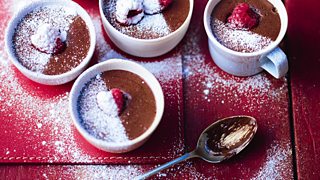10 Russian foods to feast on in front of the football
You’ve got your home cinema rigged up, you’ve cleared your diary, and you’re ready to dive headfirst into the World Cup. But what are you going to eat to keep yourself fueled during the football? It’s time to rustle up some mouth-watering morsels from the home nation. From sour soups to salads, here are a few Russian delicacies to keep even the hungriest footy fans full.
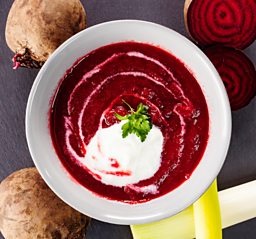
1. Borscht
No Russian menu is complete without this vibrant red beetroot soup. Served hot or cold, borscht is traditionally made from beetroot (which provides its trademark colour), cabbage (and a few other veggies), and beef broth. Serve with a nice dollop of sour cream and, whatever you do, keep away from cream carpets.
Click here to learn how to make it yourself.
2. Solyanka
For a soup less likely to stain, try solyanka. This spicy and sour soup is so hearty and thick it’s more like a stew and it comes in three basic varieties: fish, meat, and mushroom. Traditionally, the soup contained pickled cucumbers cooked with brine, giving it a characteristically salty taste. It’s not surprising then that the name solyanka comes from the Russian word for salt. Crucially, it’s believed to be an effective hangover remedy. Could come in handy if your team is victorious!
3. Blini
A thin, buckwheat or white flour pancake, the blini is Russia’s answer to the French crêpe. (For the etymology buffs out there, the name originates from the Old Slavic word “mlin”, which means “to mill”.) Blinis can be savoury or sweet: either loaded with salty smoked salmon, mushrooms or caviar or slathered with jam and condensed milk.
If you fancy baking your own then click here.
4. Caviar
Caviar – salt-cured roe, traditionally from the sturgeon fish – is a popular Russian delicacy. Serve on buttered bread, in a blini with a dollop of sour cream or eat straight from the spoon. Which, incidentally, shouldn’t be silver: the reactive metal is thought to affect the caviar’s flavour. So remember to dig out your bone, mother of pearl or gold spoon… What do you mean you don’t have one?
Click here for the BBC's caviar blini recipe.
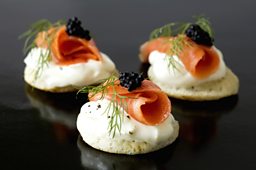
5. Shashlik
Shashlik is Russia’s version of the shish kebab. The lamb, beef, chicken or salmon, is skewered, often marinated, and then grilled. Serve with unleavened bread and pickles for the perfect post-pub pick-me-up.
To find out how to make shashlik, click here.
6. Olivier salad
Olivie – or Olivier salad – is what most of us know as Russian salad. Dice boiled potatoes, carrots, pickles, hard-boiled eggs, and meat; add peas; slather in mayonnaise and – voila! The creamy salad, in the running for the most quintessentially Russian dish out there, was in fact dreamt up by a Belgian. Lucien Olivier, the chef at one of Moscow's most celebrated restaurants, invented the “secret” recipe in the 1860s. With the speciality now served up all over the world, it looks like the secret is well and truly out.
Click here for the BBC's Russian salad recipe.
7. Pelmeni
These filled dumplings – made from thin, unleavened dough – are a cross between Chinese jiaozi and Polish pierogies. So what’s inside? Traditionally, pelmeni are stuffed with minced lamb, pork or beef, along with onions and mushrooms. They are served solo, slathered in butter or sour cream, or bobbing in a broth.
Click here to learn how to make it yourself.
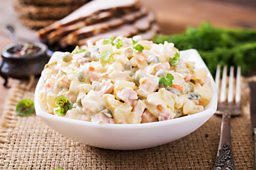
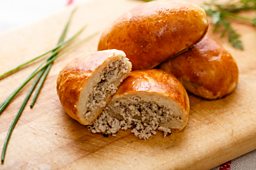
8. Pirozhki
In keeping with British footy stadium fare, pirozhki are essentially mini pies! They are hand-held, dough pockets stuffed with a whole array of sweet or savoury fillings, from beef to berries. Bake or fry for a bite-sized dose of greasy goodness.
9. Golubtsy
For anyone avoiding gluten, golubtsy offers a wheat-free alternative to the aforementioned doughy delicacies. The dish is essentially cabbage rolls: little brassica parcels stuffed with minced meat, rice and herbs and served with sour cream. Mini cabbage burritos, if you will.
Click here for the BBC's stuffed cabbage leaves recipe.
10. Tula Pryanik
Everyone likes to finish up with a pudding, so here’s a Russian delicacy to wheel out at full-time. Pryanik is Russian gingerbread, the most famous of which comes from the city of Tula, where they have been baking the snack since the 17th century. Tula gingerbread, which usually contains jam or condensed milk, is famous for its intricate and elaborate printed designs.
Try making your own pryanik, and decorating with the badge of your national team. Three lions on your gingerbread!
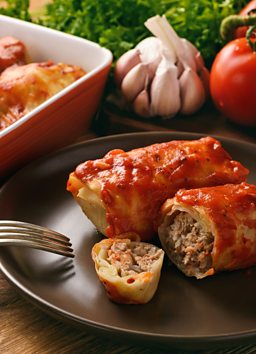
More on Russia and Food
-
![]()
The Food Programme
Investigating every aspect of the food we eat.
-
![]()
12 Russian proverbs to get you through the World Cup
More Russian trivia.
-
![]()
Cook the perfect...
Leading chefs and food writers who share their secrets for perfect home-cooked dishes.
-
![]()
Best of Today: Don't expect smiles in Russia
Advice for fans travelling to the World Cup from our Russia correspondent Steve Rosenberg.


